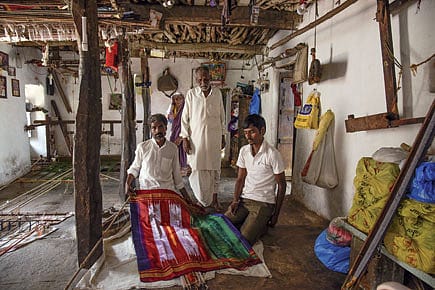The Last Weaver of Kodekal

Fringed by luminous sandy banks, the fabric flows, a perpetual stream over stones. Thick as luxury linen, though not sateen- smooth, the plain grey cotton sari is outlined by an inch of turmeric-yellow, the colour of the sun that beats down on Kodekal this morning. A village of about 8,000 people in Yadgir district, north-east Karnataka, it is the birthplace of Kodekal Basavanna, a follower of the 12-century Shaivite philosopher Basava. In this cradle of faith, another legacy has dwindled to naught. "There were 200 weaving families in the village. It was a small handloom centre. Over the years, they have all moved out or taken up other work," says 89-year-old Sangappa Manti, an award- winning artisan. "You can't blame them. If the husband and wife weave together, they may finish a sari in a couple of days and earn Rs 350 from it. Agricultural labour will fetch them double that in one day." Kodekal's past pokes through in the rattle of Sangappa Manti's wood looms. His family is the sole custodian of an unpretentious weave known as the 'dandin seere', the bordered sari. Among Kurubas and other communities of the region, the sari is a must at rituals and pujas. Made of the colours of the earth and finished with a propitious haldi border, it costs Rs 900 and lasts a lifetime.
Manti does not bemoan the fate of the customary weave that has run in his family for generations or see himself as a sentinel of tradition. The family supplements the income from weaving with a five-acre patch of sonamasuri rice. He himself diversified 20 years ago into crafting saris for temples—elaborate pure silk affairs that can take up to a month and cost about Rs 28,000. His drapes adorn dozens of goddesses in north Karnataka and he does not want for work. "I am pious. I take a shower and perform puja before I weave the sari. It takes time," he says. Pictures of Lakshmi, Shiva, Hanuman and Basava crowd the glossy green walls of Manti's front room. He wears a dhoti and an infectious smile that widens to a grin when he takes a jibe at the children scampering through the house. Shafts of white flood every room through vents in the tile-and-wood roof. There is almost no furniture, with the exception of an iron cot and a rack stacked with saris. I spy among them Ilkal cottons— a finer weave with an elaborate red silk pallu from the eponymous weaving centre 75 km south-west of Kodekal— and artificial silks. "We sell about six or seven traditional cotton saris in a month. These are usually made to order," Manti's brother's son, Veerasangappa, explains. "The rest of the time, we weave Ilkal saris, which cost more (about Rs 1,600) but are easier to sell. They are also lighter."
2025 In Review
12 Dec 2025 - Vol 04 | Issue 51
Words and scenes in retrospect
His brother Sangayya has fallen into a rhythm weaving a black sari at one of the two wooden looms occupying a large room. Spindles of brightly-dyed cotton yarn are everywhere. A brush made of tamarind fibre, used to apply jowar starch to woven fabric, hangs from a hook. The aroma of obbattu—jaggery- and-dal-stuffed crepes made of wheat— suffuses the courtyard. We are treated to a meal of jowar roti, dal, subzi and kheer, all laced with a hint of wood smoke. "When someone asks for a sari for the goddess and comes home to receive it, it is customary to cook a feast," says Ratnamma, Veerasangappa's wife, bustling about in a green Ilkal. Simplicity and generosity are converging pursuits here.
Some women in the 15-member household wear an ochre-red sari with a slim white border. It is a weaver's privilege and identity, says Sangayya, one they proudly sport at community gatherings. With the power loom yet to muscle into wardrobes in these parts, Sangappa Manti delights in weaving for his own people, giving them what has been theirs for centuries. To him, it is an extension of the struggle for freedom from the Nizam and his Razakars, who lorded over the Hyderabad region even after India had won Independence. "In 1947, when the rest of the country was celebrating, we still lived in fear. Our women did not want to step out into the streets. Then, in October, Swami Ramanand Tirtha came here from Hyderabad to organise a protest," Manti remembers. A 20-year-old Sangappa was among the thousands of men who were put behind bars, first at the Shorapur sub-jail and later in Gulbarga, for months. When Gandhi was killed, he observed a fast while in jail. It was only in September 1948, that the Nizam was finally overthrown and Hyderabad integrated into India. "You see, people here have deep roots and value their history," Manti declares in conclusion, with a knowing smile that says his saris will stay relevant for years to come.
